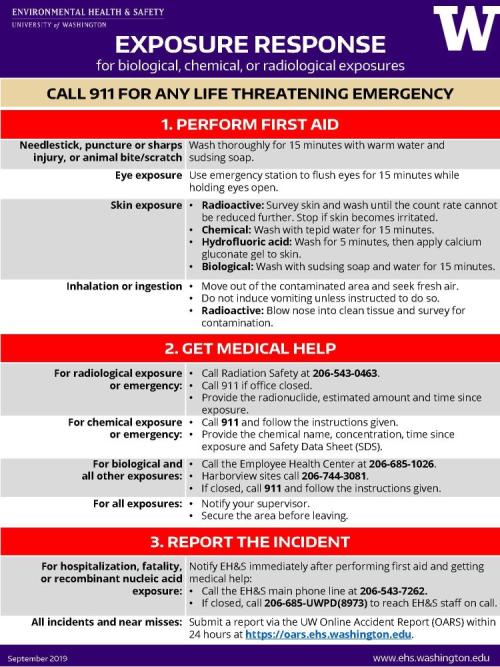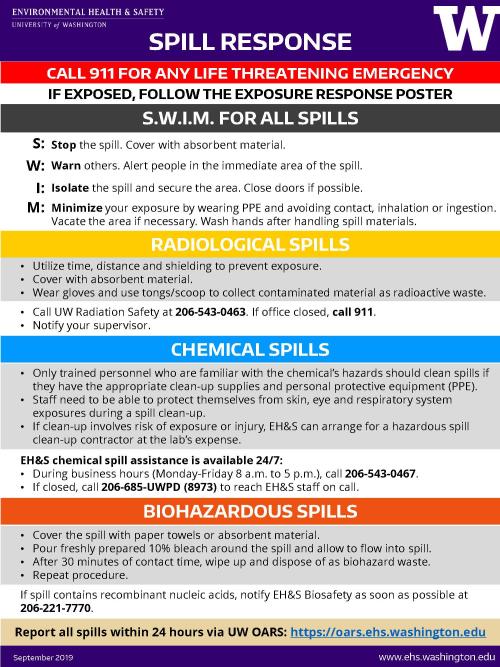Caution Signs are required to be posted at the entrance to a space where hazardous materials are stored or used. The Caution Sign is based on a location's chemical inventory; it alerts emergency responders and visitors of potential hazards and precautions for entry.
Warning Signs alert personnel and visitors to health and safety hazards beyond those identified in the Caution Sign. Specific Warning Signs may be required based on the type of hazard present.
Caution Signs

Laboratories, shops and maker spaces where hazardous materials are used or stored are required to post an up-to-date Caution Sign at the entrance.
A Caution Sign is required to be posted in a Plexiglas holder above or near the room number placard at each entrance that has a door or barrier.
The purpose of the Caution Sign is to warn emergency responders and visitors of potential hazards in the space and to meet multiple regulatory requirements. The Caution Sign consolidates signage requirements for National Fire Protection Association (NFPA) 704 Hazardous Materials, biohazardous and radioactive materials authorization, entry requirements, food and drink prohibitions and lab contact information.
Hazards listed for that location include all items listed in MyChem, the University’s chemical inventory database.
Caution Sign instructions
Signs are printed out and updated by personnel using the Caution Sign page in MyChem. It is the responsibility of personnel (responsible party, supervisor, manager, etc.) to update the signs if significant changes occur in chemical inventories, entry requirements, hazardous materials authorizations or contacts.
- Occupants replace signs as needed by updating their MyChem inventory and using the Caution Signs page available in the MyChem menu to print a new sign.
- You must have an account in the MyChem chemical inventory system to create or edit a sign based on the chemical inventory in your laboratory, shop or maker space.
- After logging into MyChem, click on the Caution Sign menu item and select the building and room (or suite) to create a customized sign for your location.
Use the Caution Signs Instructions to create and post your Caution sign, including:
- There are two kinds of Caution signs – Room Signs and Suite Signs.
- For areas or rooms with multiple entrances – caution signs must be posted at each entrance and show the same information.
- Look for rooms within a room or rooms accessible only from another room. A collection of rooms like this is considered to be a suite and needs a Suite Sign posted at each main/primary entrance, with Room Signs posted at the entrances of the inner rooms.
- Within a suite, only rooms that have a door and are used as lab spaces need a Room Sign.
- Any rooms which are not used for chemical or wet lab work but are still lab spaces (procedure room, microscope room, autoclave room, etc.) should have a Caution sign, even if the chemical diamond shows only zeros and no PPE is required.
- Alcove spaces, open benches, and corridors within a suite that are identified with a room number do not get their own Room Sign. Their inventories are combined into and reflected on the Suite Sign for the suite they are part of via the Caution Sign Tool.
- All labs that have spaces/alcoves/corridors/inner rooms which are part of a suite must identify each space/alcove/corridor/inner room by room number on the Suite Sign for that suite.
- Suites within a suite will not be listed on the same Caution signs.
Note: All chemicals, compressed gases, and compressed air tanks should be listed in MyChem under the room number that corresponds with their exact location, regardless if that room has its own Caution sign. This applies to chemicals and compressed gas tanks located in rooms without doors, alcoves, open benches, and corridors.
An example map of Caution sign locations is shown in the Caution Sign Instructions.
The hazard diamond on the caution sign uses a color-coded system with numbers to signal the degree of health hazard (blue), flammability hazard (red), and instability hazard (yellow).
The color-coded number system was developed by the National Fire Protection Association (NFPA).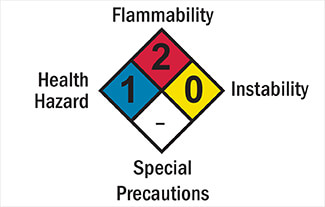
Flammability, health, and instability
Brief descriptions of the rating numbers for the flammability, health, and instability sections are given in the table below. Numbers in these sections can range from zero to four, with zero meaning essentially no hazard and four indicating an extreme hazard.
The rating numbers in the table below will appear on your Caution sign if your inventory contains quantities that require a fire permit. You may have chemicals in your lab, shop or maker space, but show zeros on your NFPA diamond if the quantities do not meet or exceed the permit quantities.
| RATING |
FIRE HAZARD (FLAMMABILITY) |
HEALTH HAZARD |
REACTIVITY (INSTABILITY) |
| 4 |
Flash point <73°F Boiling point <100°F |
Deadly | May detonate |
| 3 |
Flash point <73°F and Boiling point ≤100°F, or Flash point 73°F to 100°F |
Extreme danger | Shock and heat may detonate |
| 2 |
Boiling point >100°F and ≤100°F |
Hazardous | Violent chemical change |
| 1 |
Flash point > 200°F |
Slightly hazardous | Unstable if heated |
| 0 | Will not burn | Normal material | Stable |
Specific hazards
The bottom diamond segment is white and it shows specific hazard codes that identify special problems or require special fire-fighting techniques. These specific hazards include OX (oxidizers), COR (corrosive materials) and W (use no water to fight fires).
The numeric ratings on the colored sections of the diamond on your Caution sign are based on the hazard category and the quantity of material as recorded in your MyChem inventory.
Refer to the Table of NFPA codes and Permit Quantities for more information.
In addition to the chemical hazards listed under the NFPA diamond, hazards identified on Caution signs with pictograms include:
- Biohazards
- Compressed gases
- Cryogens
- Lead
- Radioactive materials
Sign holders for Caution signs are provided by Environmental Health & Safety (EH&S).
Sign holders are available upon request by emailing labcheck@uw.edu.
Warning Signs
Warning Sign(s) may be required to be posted in the area where a potential hazard is present, including biohazards, compressed gases, lasers, lead, liquid nitrogen, magnetic fields, radioactive materials, ultraviolet lights and x-rays.
Research and teaching laboratories with biohazards are required to post a biohazard warning sign that restricts laboratory access during work with biohazards, communicates the agents in use, and specifies entry and exit requirements.
Visit the Biological Research Safety webpage for more information.
Signage contains important hazard information regarding the gases stored and must be prominently posted in cylinder storage areas.
- A Caution Sign generated in MyChem is required to be posted at entrances to laboratories, shops, and maker spaces where hazardous materials are used and/or stored.
- The Fire Code requires rooms or cabinets containing compressed gases to be conspicuously labeled “COMPRESSED GAS.”
The Caution Sign generated in MyChem can be used to meet both of these requirements.
Visit the Compressed Gas/Cryogenic Fluids webpage for more information.
The American National Standard for Safe Use of Lasers (ANSI Z136.1) requires that lasers and laser systems have appropriate warning labels and that the rooms/laboratory in which they operate bear appropriate hazard signs to warn others of the potential hazard. Laser hazard signs must be conspicuously posted at all entrance(s) and, if deemed necessary by the laser safety officer, should also be posted within the laser-controlled area.
The word "Danger” or “Warning” must be used with all signs and labels associated with all lasers and laser systems that exceeded the MPE for irradiance, including all Class 3B and Class 4 lasers or laser systems. The laser-specific (type), Optical Density (OD) of the protective eyewear and wavelength shall be shown on the sign for a location requiring the use of eyewear.
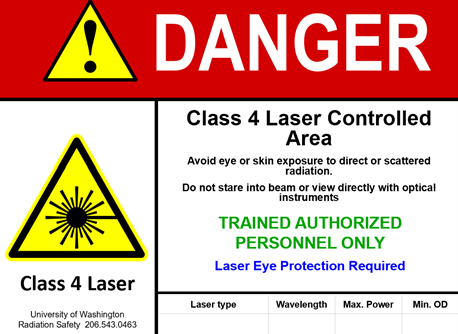

The word “Notice” must be used on signs posted outside temporary laser-controlled area when service or maintenance is in-process.
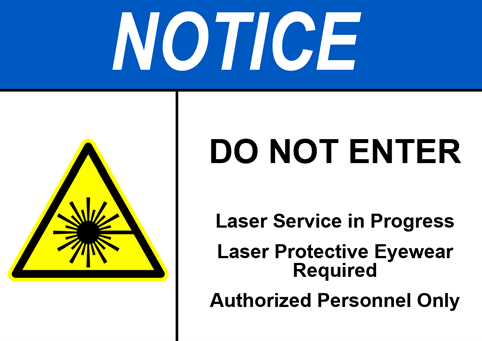
Laser hazard warning, danger, or notice signs and labels (except lighted hazards warning signs) are provided by the laser safety officer and are available from EH&S Radiation Safety Office.
Shops, makerspaces and labs may use lead-containing products such as solder, or work with lead-containing chemicals or items in their research or soldering area with fume extractors academic work. Common lead-containing chemicals used in UW labs in small quantities include lead acetate, lead oxide, lead chloride, lead iodide, lead nitrate and lead metal.
Shops, makerspaces and labs where lead-containing products are used or stored are required to ensure signs are posted indicating lead hazards.
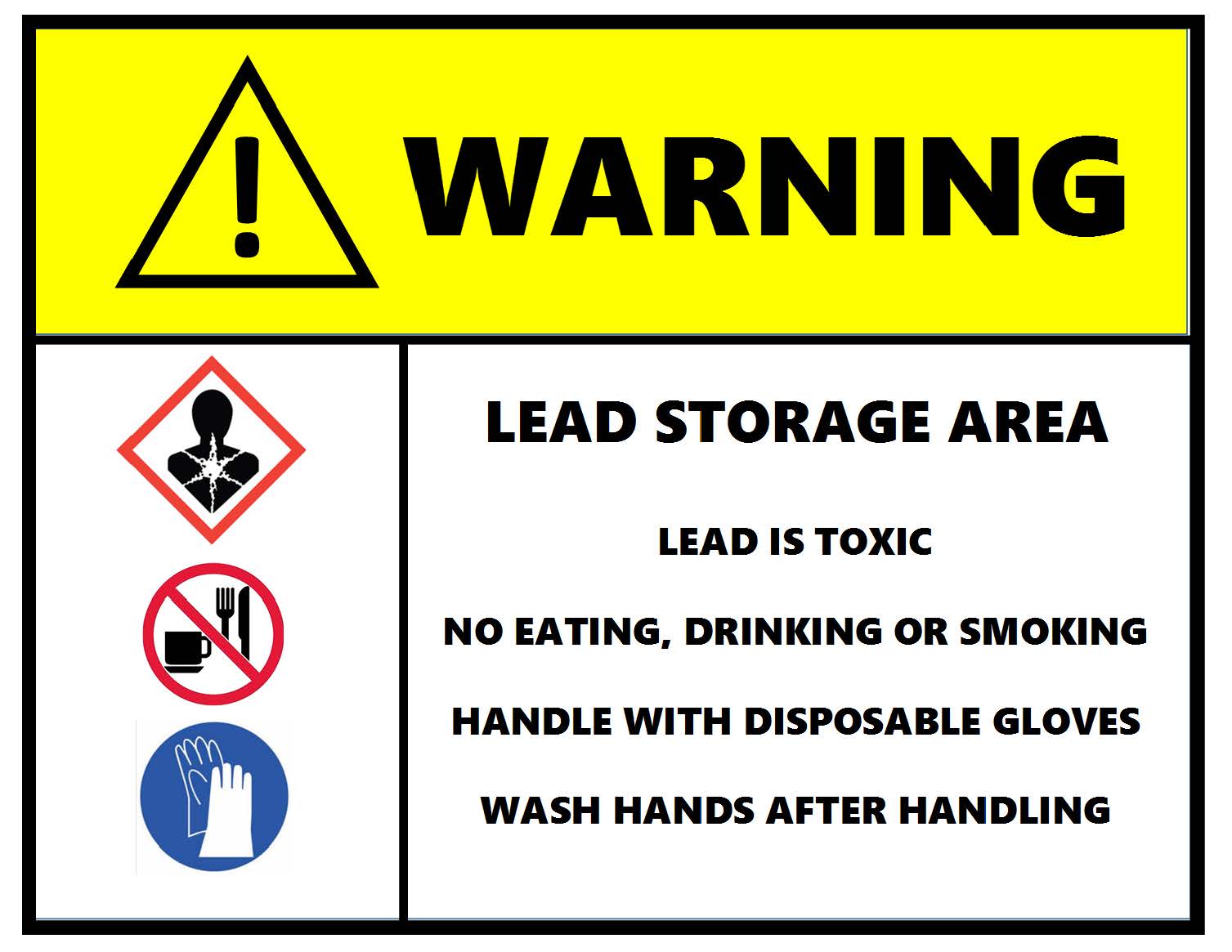
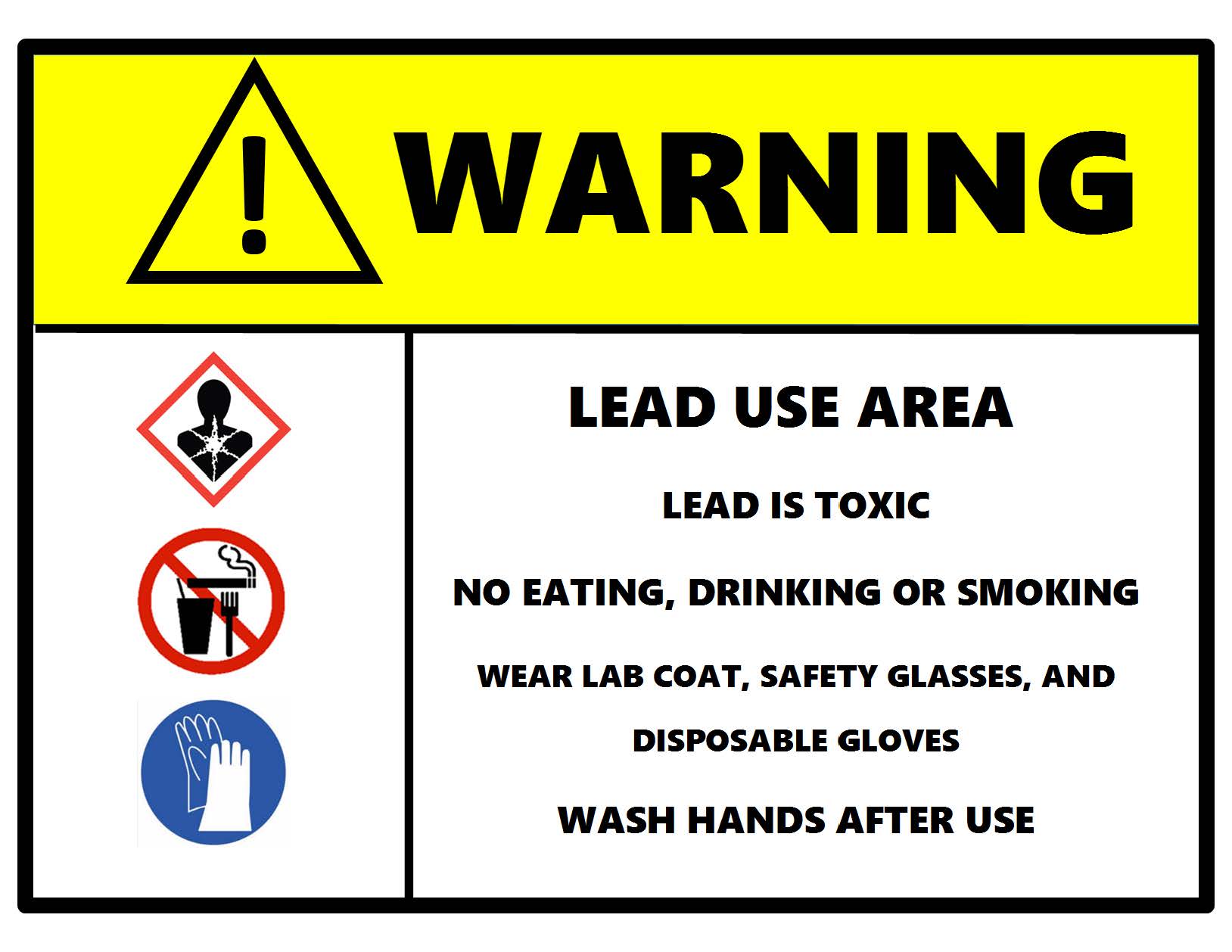
Due to the large liquid to gas expansion that takes place upon evaporation, liquid nitrogen (LN2) is capable of displacing sufficient oxygen to create an oxygen-deficient environment in a small or insufficiently ventilated space, leading to the risk of asphyxiation.
Working in or entering an oxygen deficient atmosphere may cause unconsciousness without warning, potentially leading to asphyxiation and death. To avoid such conditions, liquid nitrogen should only be stored, handled and used in well ventilated areas with oxygen alarms and signage warning of the asphyxiation hazard.
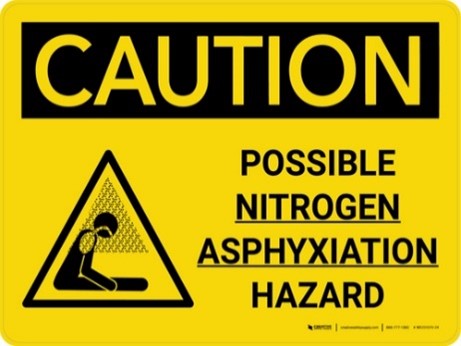
University personnel are required to complete training covering the hazards of working with LN2 prior to beginning work.
The use of strong magnetic fields such as nuclear magnetic resonance (NMR) devices and super-conducting magnets in the laboratories require strict guidance because of the hazards associated with these devices. These magnets present exposure and physical hazards on ferromagnetic objects such as keys, scissors, knives, wrenches, oxygen cylinders and those with surgical implants, electronic or electromagnetic prosthetic devices and bioelectronic devices.
Research and teaching laboratories with magnet hazards are required to post hazard danger sign that restricts access prohibiting unauthorized personnel in the area and communicates the potential hazards. The below hazard signage shall be posted:
- On magnet equipment with field strengths greater than 5 gauss (0.5mT)
- At all entrance(s) to facilities housing magnets with field strength of 30 gauss (3mT)
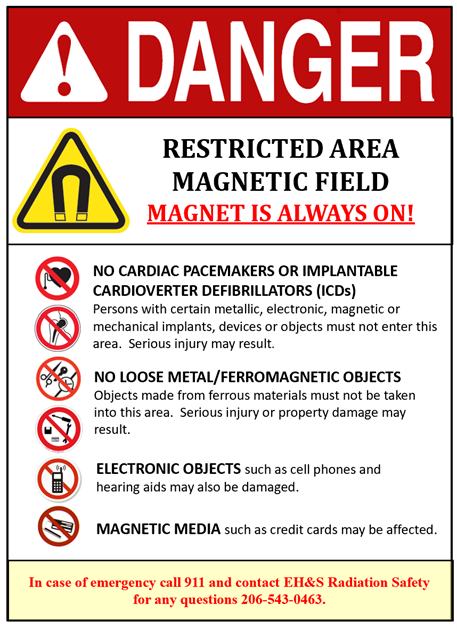
Magnet warning sign are provided by EH&S Radiation Safety Office.
Appropriate radiation warning signs or labels must be used to designate radiation areas and to identify radioactive material containers or rooms containing radioactive materials. During the setup of a new laboratory, Radiation Safety staff post or provide appropriate signage, but the PI is responsible for maintaining that posting. Requirements for the types and locations of these signs or labels are provided in the UW Radiation Safety Manual.
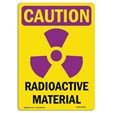
Any equipment that emits UV radiation must be conspicuously labeled with caution signage. The “CAUTION: UV Radiation Hazard” sign must also be posted at all entrance(s) to the lab/room during UV irradiation and/or on the biosafety cabinet.
It may be necessary to install warning lights and to limit exposure time, if necessary by EH&S Radiation Safety.
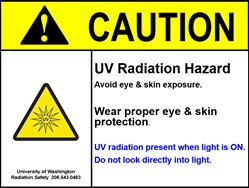

Caution UV light signs are provided by EH&S Radiation Safety Office.
Appropriate radiation warning sign and labels must be posted on the X-ray source housing, near a switch that energizes the X-ray, and on entrances to lab/room containing open beam x-ray source. During setup of the radiation-producing machine, RS will post and provide appropriate signage for the lab/room/equipment.
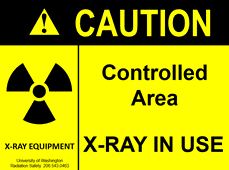
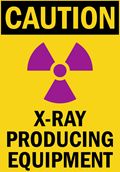
"CAUTION: X-ray" signs are provided by EH&S Radiation Safety Office.
Spill and Exposure Response Posters
Post the Spill Response Poster and Exposure Response Poster (as applicable) in your workspace for quick reference in case of a hazardous material spill, release or exposure.
Services available
Sign holders for Caution signs are provided by Environmental Health & Safety (EH&S) and available upon request by emailing labcheck@uw.edu.
Please read the FAQ section below or contact EH&S if you have questions about creating a Caution sign.
EH&S is available for consultation on selecting the appropriate warning signs for the specific hazards in your work area.
Frequently asked questions
The International Fire Code and some other regulations stipulate posting of Caution and warning signs under certain conditions.
For detailed information, refer to the links listed under Regulation and Policy section of this page.
The Caution sign (that is printed from MyChem and posted at the entrance of a location with hazardous materials) provides information for:
- Emergency responders (police, fire, medical, spill response)
- Visitors (vendors, contractors, students, and colleagues from other institutions)
- UW authorized personnel such as EH&S staff, facilities services and custodial staff
- General public who may pass by lab or shop
Any UW laboratory, shop or maker space where hazardous materials are used and/or stored is required to have a Caution sign printed from MyChem.
Labs, shops and maker spaces that have only computers or mechanical equipment (and no chemicals) would not need a Caution sign. In this case, you may choose to have a Caution sign to indicate that no chemical hazards are present and to display contact information and the “No Food or Drink” image.
If you have an account in MyChem, the UW online chemical inventory system, you can make a Caution sign for any of the rooms for which you have authorization.
Contact EH&S at labcheck@uw.edu if you need a holder for the Caution sign you printed from MyChem.
Contact EH&S at mychem@uw.edu or (206) 616-5835.
One name is required for the Caution sign, although it will accommodate up to six contacts. A department contact, such as an administrator, is recommended for general information.
Lab, shop or maker space contacts are recommended for emergencies and entry after normal business hours. A home phone number, cell phone number or 9-1-1 may be typed in "After Hours Phone" column.
Home phone numbers can be added or modified under the menu item My Contacts in MyChem.
"UW Authorized personnel" (shown at the top of a Caution sign printed from MyChem) generally refers to:
-
Anyone assigned to work in the space
-
Anyone who has been specifically authorized to enter the space
-
UW personnel who, as a part of their responsibility, provide services to spaces such as UW Facilities staff, custodians, EH&S staff and UW Police
-
Labs and shops may restrict entry to protect staff or protect their research and require entry by permission only
The principal investigator, safety coordinator or their authorized designee decides who is authorized to enter.
EH&S installs acrylic sign holders, usually near the room number plaque. If no sign holder is outside your door, please contact EH&S at (206) 685-0341.
The best way to remove a sign from the holder is to stick the sticky side of a piece of 'post-it' note paper between the plexiglass and the paper sign, so the sticky part is touching the paper sign. Push on the outside of the plexiglass to stick the post-it to the paper sign and slowly pull on the post-it. The sign should slide right out.
The principal investigator, responsible person, supervisor, safety coordinator or their authorized designee is responsible for keeping Caution and warning signs up-to-date.
The NFPA hazard diamond provides a quick reference for emergency responders about materials in a room that may present health, flammability, instability, or special hazards under conditions of fire, spill, or similar emergencies. Refer to the section above "NPFA hazard diamond" for more information.
You may not have enough flammable liquids to warrant the flammability rating. You need to have five gallons total (threshold quantity requiring a Seattle Fire Department permit) of certain classes of flammable liquids to require a number in the red diamond on your sign. Refer to the Table of NFPA Codes and Permit Quantities for the threshold quantities for each hazard category.
Alternatively, your MyChem inventory may be inaccurate. MyChem performs calculations using your MyChem inventory to determine the numeric hazard ratings for the diamond, so if your inventory is inaccurate, your sign will be inaccurate.
The biohazard symbol on the Caution sign indicates that the lab, shop or maker space is authorized at the BSL-1, BSL-2, or BSL-3 level.
If biohazardous materials are present and being manipulated in the lab, shop or maker space, additional sign with more information is required to be posted on the door. For more information, please visit the Biological Research Safety page.
If you have any compressed gas cylinders in your lab, shop or maker space (and it is listed in your MyChem inventory) the compressed gas symbol will appear on your Caution sign. However, compressed gases will only be listed under the NFPA fire diamond if they meet the permit threshold quantities. Refer to the Table of NFPA Codes and Permit Quantities for more information.
Check to make sure the gases are entered in your MyChem inventory. Your compressed gases need to be entered in MyChem in order for the symbol to appear on your sign.
There are a variety of regulatory required signs that are not covered by the Caution sign printed from MyChem. Some signs required by regulations were purposely omitted from the Caution sign primarily because they are too complex or variable.
Examples include:
- Laser warnings
- UV light hazards
- Strong magnets
- Radiation signs for X-ray and high radiation hazards
- Biosafety Level 2 and 3 signs restricting access while work is in progress
- Microwave radiation signs
Locations with the hazards listed above are required to post a separate warning sign indicating the hazard.
More Information
The regulatory requirements listed below are addressed by the caution sign.
- Seattle Fire Code (PDF) Items 5 and 7 require NFPA diamond and compressed gas label
- State Department of Health (WAC 246-221-120) requires radiation symbol
- CDC/NIH Biosafety in Microbiological and Biomedical Laboratories (PDF) BMBL guidance requires posting of a biohazard sign (Section IV.A.9), personal protection requirements (Section IV. A.9 - Biosafety Level 2 and above), and general occupational health requirements (Section IV A. 3)
- Washington State Bloodborne Pathogens rule requires biohazard sign on containers
- NIH Guidelines for Recombinant DNA require biohazard sign, Appendix G-II-C-2-e
- Food or drink is prohibited in laboratories/shops by federal and state regulations and UW policy:
-
Labor and Industries Rule WAC 296-823-14035
-
Department of Health Radioactive Materials Rules WAC 246-235-130
-
UW Laboratory Safety Manual, Section 2 A.4
-
- UW Biosafety Manual Section IV B.2 (PDF)
- NIH Guidelines for Recombinant DNA, Appendix G-II-A-1-e
- WAC-296-800-140 Create an Accident Prevention Program
